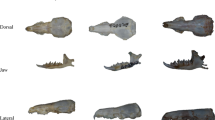Abstract
Multivariate statistical measures of biological distance utilizing non-metric traits on the human cranium was first explored by Berry and Berry (1967) utilizing the multivariate statistics developed by C.A.B. Smith and known as the Grewal-Smith statistic (Grewal, 1962). By 1975 attempts were being made in the classification of human crania by means of non-metric traits in order to assign one or some few individuals into a parent or larger group (SjØvold, 1975; Finnegan, 1975). However, these first attempts at classification utilized very cumbersome statistics (hypergeometric probabilities), and the methods had a high rate of mis-classification. The “tally” method (Anderson, 1968) was also utilized, but did not provide the accuracy in classification that Anderson had originally achieved.
Access this chapter
Tax calculation will be finalised at checkout
Purchases are for personal use only
Preview
Unable to display preview. Download preview PDF.
Similar content being viewed by others
References
Anderson, J.E.: 1968, Skeletal “Anomalies” as Genetic indicators. In: The Skeletal Biology of Earlier Human Populations. D.R. Brothwell, ed. Pergamon Press, London.
Bahadur, R.R.: 1961, A representation of the joint distribution of responses in n dichotomous variables. In: Studies in Item Analysis and Prediction. H. Solomon, ed. Palo Alto, Stanford University Press.
Berry, A.C.: 1974, Non-metrical variation in the prosimian skull. Prosimian Biology (Ed.) Martin, R.D., G.A. Doyle, & A.C. Walker, University of Pittsburg Press.
Berry, A.C. and R.J. Berry: 1967, Epigenetic variation in the human cranium. Journal of Anatomy. Vol. 101, No. 2, pp. 361–379.
Berry, A.C. and R.J. Berry: 1971, Epigenetic polymorphism in the primate skeleton. In: Comparative Genetics in Monkeys, Apes and Man. In D. Brothwell and A.B. Chiarelli (eds.), Academic Press, London.
Berry RJ: 1979, Section I. Genes and skeletons, ancient and modern. J. Human Evolution. 8, 7, 669–677.
Buikstra, J.E. and T.L. Pistono: 1978, Non-metric traits in forensic research: A case study. Paper presented at the annual meeting of the American Academy of Forensic Sciences. 23 February 1978, St. Louis.
Cooprider, K.B.: 1978, Racial Classification based on non-metric skeletal traits. M.A. Report, Kansas State University.
Cooprider, K.B., R.M. Rubison, and M. Finnegan: 1980, Racial classification based on non-metric skeletal traits. Homo. Vol. 31, No. 1, pp. 1–21.
Duda, R.O., and P.E. Hart: 1973, Pattern Classification and Scene Analysis. New York: John Wiley and Sons.
Finnegan, M.: 1975, The use of non-metric traits in assigning individuals to a parent or larger group. Paper presented at the Plains Conference, 7 November 1975, Lincoln, Nebraska.
Finnegan, M.: 1977, Non-metric traits and forensic identification. Paper presented at the 29th annual meeting of the American Academy of Forensic Sciences, February 17, San Diego, California.
Finnegan, M.: 1978, An analysis of intra-observer error in nonmetric studies. Abstract: American Journal of Physical Anthropology, Vol. 48, No. 3, p. 393.
Finnegan, M. and K. Cooprider: 1978, Empirical comparison of distance equations using discrete traits. American Journal of Physical Anthropology. Vol. 49, No. 1, pp. 39–46.
Finnegan, M. and S.A. McGuire: 1979, Classification systems for discrete variables used in forensic anthropology. American Journal of Physical Anthropology. Vol. 51, No. 4, pp. 547–553.
Finnegan, M. and R.M. Rubison: 1980, The assessment and analysis of interobserver error in non-metric cranial studies. American Journal of Physical Anthropology, Vol. 52, No. 2, p. 226.
Gilbert, E.S.: 1968, On discrimination using qualitative variables. Journal of the American Statistical Association, Vol. 63. pp. 116–122.
Green, R.F. and J.M. Suchey: 1976, The use of inverse sine transformations in the analysis of non-metric cranial data. American Journal of Physical Anthropology. Vol. 45, pp. 61–68.
Green, R.F., J.M. Suchey, and D.V. Gokhale: 1979, The statistical treatment of correlated bilateral traits in the analysis of cranial material. American Journal of Physical Anthropology, Vol. 50, No. 4, pp. 629–634.
Grewal, M.S.: 1962, The rate of genetic divergence of sublines in the C57BL strain of mice. Genetics Research, Vol. 3, pp. 226–237.
Molto, J.E.: 1979, The assessment and meaning of intraobserver error in population studies based on discontinuous cranial traits. American Journal of Physical Anthropology, Vol. 51, No. 3, pp. 333–344.
Moore, D.H., II: 1973, Evaluation of five discrimination procedures for binary variables. Journal of the American Statistical Association, Vol. 68, pp. 399–404.
Osteyee, D.B. and J.G. Good: 1974, Information, weight of evidence, the singularity between probability measures and signal detection. Lectures Notes in Mathematics, No. 376. Berlin: Springer Verlag.
Rees, J.W. : 1969a, Morphologic variation in the cranium and mandible of the white-tailed deer (Odocoileus virginianus): a comparative study of geographical and four biological distances. Journal of Morphology, Vol. 128, No. 1, pp. 95–112.
Rees, J.W.: 1969b, Morphologic variation in the mandible of the white-tailed deer (Odocoileus virginianus): a study of popula- tional skeletal variation by principal component and canonical analysis. Journal of Morphology. Vol. 128, No. 1, pp. 113–130.
Rubison, R.M. : 1979, Classification based on correlated bilateral non-metric traits. Technical Report # 38, Department of Statistics and Statistical Laboratory, Kansas State University.
Russell, F.: 1900, Studies on cranial variation. American Naturalist. Vol. 34, pp. 737–745.
Sjøvold, T.: 1975, Allocation of single or some few individuals to one of two or more groups by means of non-metrical variants in the skeleton. OSSA, Vol. 2, pp. 4l-46.
Sjøvold, T.: 1977, Non-metrical Divergence Between Skeletal Populations. OSSA, Vol. 4, Supplement 1, 133 p.
Suchey, Judy: 1976, Use of non-metric skeletal traits in forensic cases. Paper presented at the 28th annual meeting of the American Academy of Forensic Sciences, Washington, D.C., February, 1976.
Trinkaus, E.: 1978, Bilateral asymmetry of human skeletal nonmetric traits. American Journal of Physical Anthropology. Vol.49, No. 3, pp. 315–318.
Author information
Authors and Affiliations
Editor information
Editors and Affiliations
Rights and permissions
Copyright information
© 1984 D. Reidel Publishing Company
About this chapter
Cite this chapter
Finnegan, M., Rubison, R.M. (1984). Multivariate Distances and Multivariate Classification Systems Using Non-Metric Traits in Biological Studies. In: Van Vark, G.N., Howells, W.W. (eds) Multivariate Statistical Methods in Physical Anthropology. Springer, Dordrecht. https://doi.org/10.1007/978-94-009-6357-3_6
Download citation
DOI: https://doi.org/10.1007/978-94-009-6357-3_6
Publisher Name: Springer, Dordrecht
Print ISBN: 978-94-009-6359-7
Online ISBN: 978-94-009-6357-3
eBook Packages: Springer Book Archive




